View in other NatureServe Network Field Guides
NatureServe
Montana
Utah
Wyoming
Idaho
Wisconsin
British Columbia
South Carolina
Yukon
California
New York
Cabbage White - Pieris rapae
General Description
[From Ferris and Brown 1981; Scott 1986; Opler and Wright 1999; Glassberg 2001; Pyle 2002] Forewing 2.1-2.8 cm. White overall. Uppersurface of forewing with charcoal to black tip and one (male) or two (female) postmedian black spots, one spot on leading edge of hindwing. Undersurface uniformly white with yellowish tint, prominent black spot on forewing with smaller adjacent spot, no marbling or markings tracing hindwing veins.
Phenology
Many flights, mid-April to October in the north; one flight, mostly June in far north (Scott 1986). Continuous flights from early spring to killing frost (Glassberg 2001). March to first killing frost of autumn in the Rocky Mountain states (Ferris and Brown 1981). Early April to early October in south-central Colorado (Scott and Scott 1978), early March to early November in Oregon and Washington (Pyle 2002), late February to mid-October in Oregon (Warren 2005), March to November in British Columbia (Threatful 1988; Guppy and Shepard 2001).
Diagnostic Characteristics
Best determined by charcoal to black wing tip and overall white color on upper surface, with one or two prominent postmedian black spots, undersurface uniformly white with yellowish tint, prominent black spot on forewing and no marbling or markings tracing veins of hindwing.
Species Range
Montana Range
Range Descriptions
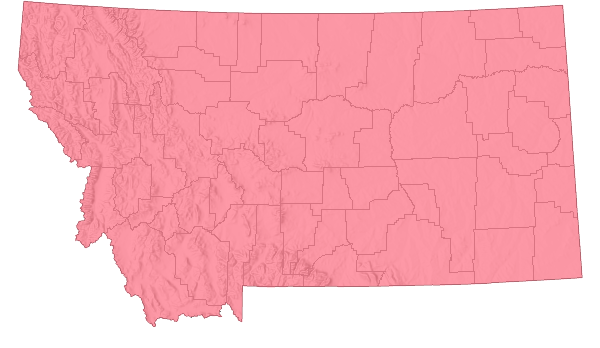
 Non-native
Non-native
Range Comments
Holarctic; introduced to North America. In NA across Canada from the southern boreal regions south throughout the US to northern Mexico; wanders farther north to southeastern Alaska, the northern regions of British Columbia, Alberta, Saskatchewan, Manitoba, Ontario (Scott 1986; Opler and Wright 1999; Glassberg 2001); 1310 m to at least 2743 m elevation in Colorado (Scott and Scott 1978), sea level to at least 2438 m elevation in Oregon (Warren 2005), 456 m to 549 m elevation in southeastern British Columbia (Threatful 1988). In Montana, reported from all counties (Kohler 1980; Stanford and Opler 1993; FLMNH Lepidopterists' Society database). Mainly uncommon to common, rare at southern edge of range (Glassberg 2001).
Observations in Montana Natural Heritage Program Database
Number of Observations: 83
(Click on the following maps and charts to see full sized version)
Map Help and Descriptions
Relative Density
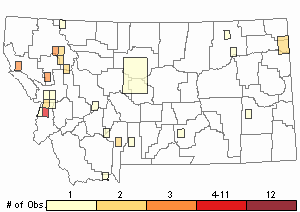
Recency
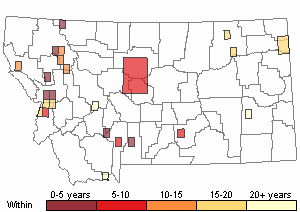
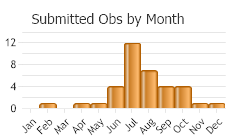

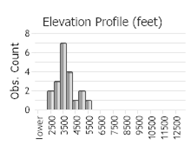 (Observations spanning multiple months or years are excluded from time charts)
(Observations spanning multiple months or years are excluded from time charts)
Migration
Migratory in Europe, non-migratory in North America; adults move up to 12 km but mostly < 1 km (Scott 1986).
Habitat
Open disturbed sites, cities, suburbs, vegetable gardens, valley bottoms, montane meadows, streamsides, desert washes, roadsides, commercial cropland (Ferris and Brown 1981; Scott 1986; Opler and Wright 1999; Glassberg 2001; Pyle 2002). In Glacier National Park, Montana reported from montane mesic meadows and above treeline in alpine terrain (Debinski 1993); in the Greater Yellowstone Ecosystem, reported in open woodlands, roadsides, agricultural areas (Debinski and Pritchard 2002).
Food Habits
Larval food plants are primarily those containing mustard oils, and include commercial crop species and natives such as Arabis, Armoracia, Barbarea, Brassica (many species), Caulanthus, Cakile, Capparis, Cardaria, Capsella, Cleome, Dentaria, Descuraina, Eruca, Erysimum, Hesperis, Lepidium (several species), Lobularia, Lunaria, Malcolmia, Matthiola, Nasturtium, Raphanus, Reseda, Rorippa, Sisymbrium (several species), Streptanthus, Thlaspi, and Tropaeolum (Emmel et al. 1970; Scott 1986, 1992, 2006; Guppy and Shepard 2001; Warren 2005). Adults feed on flower nectar (including Agalinis, Agastache, Anchusa, Apocynum, Arctium, Asclepias, Barbarea, Berteroa, Bidens, Blephilia, Boltonia, Brassica, Brickellia, Buddleia, Cardamine, Carduus, Caryopteris, Centaurea, Centranthus, Cephalanthus, Cerastium, Chrysanthemum, Chrysothamnus, Cirsium, Cleome, Convolvulus, Conyza, Coreopsis, Cornus, Coronilla, Crotalaria, Cryptantha, Cucumis, Cucurbita, Cuphea, Delphinium, Dipsacus, Epilobium, Erigeron, Eriodictyon, Erythronium, Eupatorium, Fragaria, Gazania, Geranium, Glechoma, Grindelia, Helianthus, Hesperis, Heterotheca, Justicia, Lactuca, Lavandula, Lepidium, Lesquerella, Liatris, Linaria, Lithospermum, Lobelia, Lycium, Lythrum, Machaeranthera, Malva, Matricaria, Medicago, Mentha, Mertensia, Monarda, Nasturtium, Nepeta, Nothoscordum, Origanum, Oxalis, Perovskia, Phaseolus, Plantago, Polygonum, Potentilla, Prunella, Pycnanthemum, Ranunuculus, Raphanus, Ribes, Rubus, Rudbeckia, Salvia, Scabiosa, Sedum, Senecio, Sisymbrium, Sium, Solanum, Solidago, Stachys, Symphyotrichum, Syringa, Taraxacum, Teucrium, Thlaspi, Trifolium, Triodanis, Verbena, Veronica, Viguiera, Viola, Zinnia) and mud (Scott 1986, 2014; Pyle 2002; Tooker et al. 2002; Warren 2005).
Reproductive Characteristics
Females lay eggs singly on host plant leaves; lifetime fecundity varies from about 100-750 eggs. Females may live about 21 days in captivity, usually < 7 days in the wild (Scott 1986, 1992, 2006; James and Nunnallee 2011). Eggs hatch in about 3-5 days (depending on temperature and cohort), develop from egg-hatch to L5 instar and pupae in 14-21 days, adults eclose (emerge from pupae) in 7-12 days. Temperature and photoperiod determine production of diapause or non-diapause larvae, temperature > 24 C prevents diapause regardless of day length (James and Nunnallee 2011). Young larvae move little, feed mostly on underside of host plant leaves, build no nest; older larvae more mobile, are cannibalistic on eggs, hibernate as pupae (Scott 1979, 1986; James and Nunnallee 2011). Males patrol throughout the day near larval host plants in riparian areas or in cultivated fields in search of females (Scott 1975b, 1986).
Management
Stewardship Responsibility
References
- Literature Cited AboveLegend:
 View Online Publication
View Online Publication Debinski, D. 1993. Butterflies of Glacier National Park, Montana. Occasional Papers of the Museum of Natural History, the University of Kansas, Lawrence, Kansas. No. 159: 1-13.
Debinski, D. 1993. Butterflies of Glacier National Park, Montana. Occasional Papers of the Museum of Natural History, the University of Kansas, Lawrence, Kansas. No. 159: 1-13. Debinski, D.M. and J.A. Pritchard. 2002. A field guide to the butterflies of the Greater Yellowstone Ecosystem. Lanham, MD: Roberts Rinehart Publishers. 107 p.
Debinski, D.M. and J.A. Pritchard. 2002. A field guide to the butterflies of the Greater Yellowstone Ecosystem. Lanham, MD: Roberts Rinehart Publishers. 107 p. Emmel, J.F., O. Shields, and D.E. Breedlove. 1970. Larval foodplant records for North American Rhopalocera Part 2. Journal of Research on the Lepidoptera 9(4): 233-242.
Emmel, J.F., O. Shields, and D.E. Breedlove. 1970. Larval foodplant records for North American Rhopalocera Part 2. Journal of Research on the Lepidoptera 9(4): 233-242. Ferris, C.D. and F.M. Brown (eds). 1981. Butterflies of the Rocky Mountains. Univ. of Oklahoma Press. Norman. 442 pp.
Ferris, C.D. and F.M. Brown (eds). 1981. Butterflies of the Rocky Mountains. Univ. of Oklahoma Press. Norman. 442 pp. Glassberg, J. 2001. Butterflies through Binoculars: A Field Guide to the Butterflies of Western North America. Oxford University Press.
Glassberg, J. 2001. Butterflies through Binoculars: A Field Guide to the Butterflies of Western North America. Oxford University Press. Guppy, C.S. and J.H. Shepard. 2001. Butterflies of British Columbia: including western Alberta, southern Yukon, the Alaska Panhandle, Washington, northern Oregon, northern Idaho, northwestern Montana. UBC Press (Vancouver, BC) and Royal British Columbia Museum (Victoria, BC). 414 pp.
Guppy, C.S. and J.H. Shepard. 2001. Butterflies of British Columbia: including western Alberta, southern Yukon, the Alaska Panhandle, Washington, northern Oregon, northern Idaho, northwestern Montana. UBC Press (Vancouver, BC) and Royal British Columbia Museum (Victoria, BC). 414 pp. James, D.G. and D. Nunnallee. 2011. Life histories of Cascadia butterflies. Corvallis, OR: Oregon State University Press. 447 p.
James, D.G. and D. Nunnallee. 2011. Life histories of Cascadia butterflies. Corvallis, OR: Oregon State University Press. 447 p. Kohler, S. 1980. Checklist of Montana Butterflies (Rhopalocera). Journal of the Lepidopterists' Society 34(1): 1-19.
Kohler, S. 1980. Checklist of Montana Butterflies (Rhopalocera). Journal of the Lepidopterists' Society 34(1): 1-19. Opler, P.A. and A.B. Wright. 1999. A field guide to western butterflies. Second edition. Peterson Field Guides. Houghton Mifflin Company, Boston, Massachusetts. 540 pp.
Opler, P.A. and A.B. Wright. 1999. A field guide to western butterflies. Second edition. Peterson Field Guides. Houghton Mifflin Company, Boston, Massachusetts. 540 pp. Pyle, R.M. 2002. The butterflies of Cascadia: a field guide to all the species of Washington, Oregon, and surrounding territories. Seattle Audubon Society, Seattle, Washington. 420 pp.
Pyle, R.M. 2002. The butterflies of Cascadia: a field guide to all the species of Washington, Oregon, and surrounding territories. Seattle Audubon Society, Seattle, Washington. 420 pp. Scott, J.A. 1975b. Mate-locating behavior of western North American butterflies. Journal of Research on the Lepidoptera 14:1-40.
Scott, J.A. 1975b. Mate-locating behavior of western North American butterflies. Journal of Research on the Lepidoptera 14:1-40. Scott, J.A. 1979. Hibernal diapause of North American Papilionoidea and Hesperioidea. Journal of Research on the Lepidoptera 18(3): 171-200.
Scott, J.A. 1979. Hibernal diapause of North American Papilionoidea and Hesperioidea. Journal of Research on the Lepidoptera 18(3): 171-200. Scott, J.A. 1986. The butterflies of North America: a natural history and field guide. Stanford University Press, Stanford, California.
Scott, J.A. 1986. The butterflies of North America: a natural history and field guide. Stanford University Press, Stanford, California. Scott, J.A. 1992. Hostplant records for butterflies and skippers (mostly from Colorado) 1959-1992, with new life histories and notes on oviposition, immatures, and ecology. Papilio new series #6. 185 p.
Scott, J.A. 1992. Hostplant records for butterflies and skippers (mostly from Colorado) 1959-1992, with new life histories and notes on oviposition, immatures, and ecology. Papilio new series #6. 185 p. Scott, J.A. 2006. Butterfly hostplant records, 1992-2005, with a treatise on the evolution of Erynnis, and a note on new terminology for mate-locating behavior. Papilio new series #14. 74 p.
Scott, J.A. 2006. Butterfly hostplant records, 1992-2005, with a treatise on the evolution of Erynnis, and a note on new terminology for mate-locating behavior. Papilio new series #14. 74 p. Scott, J.A. 2014. Lepidoptera of North America 13. Flower visitation by Colorado butterflies (40,615 records) with a review of the literature on pollination of Colorado plants and butterfly attraction (Lepidoptera: Hersperioidea and Papilionoidea). Contributions of the C.P. Gillette Museum of Arthopod Diversity. Fort Collins, CO: Colorado State University. 190 p.
Scott, J.A. 2014. Lepidoptera of North America 13. Flower visitation by Colorado butterflies (40,615 records) with a review of the literature on pollination of Colorado plants and butterfly attraction (Lepidoptera: Hersperioidea and Papilionoidea). Contributions of the C.P. Gillette Museum of Arthopod Diversity. Fort Collins, CO: Colorado State University. 190 p. Scott, J.A. and G.R. Scott. 1978. Ecology and distribution of the butterflies of southern central Colorado. Journal of Research on the Lepidoptera 17(2): 73-128.
Scott, J.A. and G.R. Scott. 1978. Ecology and distribution of the butterflies of southern central Colorado. Journal of Research on the Lepidoptera 17(2): 73-128. Stanford, R.E. and P.A. Opler. 1993. Atlas of western USA butterflies: including adjacent parts of Canada and Mexico. Unpubl. Report. Denver and Fort Collins, Colorado 275 pp.
Stanford, R.E. and P.A. Opler. 1993. Atlas of western USA butterflies: including adjacent parts of Canada and Mexico. Unpubl. Report. Denver and Fort Collins, Colorado 275 pp. Threatful, D.L. 1988. A list of the butterflies and skippers of Mount Revelstoke and Glacier National Parks, British Columbia, Canada (Lepidoptera). Journal of Research on the Lepidoptera 27(3-4): 213-221.
Threatful, D.L. 1988. A list of the butterflies and skippers of Mount Revelstoke and Glacier National Parks, British Columbia, Canada (Lepidoptera). Journal of Research on the Lepidoptera 27(3-4): 213-221. Tooker, J.F., P.F. Reagel, and L.M. Hanks. 2002. Nectar sources of day-flying lepidoptera of central Illinois. Annals of the Entomological Society of America 95(1): 84-96.
Tooker, J.F., P.F. Reagel, and L.M. Hanks. 2002. Nectar sources of day-flying lepidoptera of central Illinois. Annals of the Entomological Society of America 95(1): 84-96. Warren, A.D. 2005. Lepidoptera of North America 6: Butterflies of Oregon, their taxonomy, distribution, and biology. Contributions of the C. P. Gillette Museum of Arthropod Diversity, Colorado State University. Fort Collins, Colorado. 406 pp.
Warren, A.D. 2005. Lepidoptera of North America 6: Butterflies of Oregon, their taxonomy, distribution, and biology. Contributions of the C. P. Gillette Museum of Arthropod Diversity, Colorado State University. Fort Collins, Colorado. 406 pp.
- Additional ReferencesLegend:
 View Online Publication
View Online Publication
Do you know of a citation we're missing? Allen, T.J., J.P. Brock, and J. Glassberg. 2005. Caterpillars in the field and garden: a field guide to the butterfly caterpillars of North America. Oxford University Press.
Allen, T.J., J.P. Brock, and J. Glassberg. 2005. Caterpillars in the field and garden: a field guide to the butterfly caterpillars of North America. Oxford University Press. Brock, J.P. and K. Kaufman. 2003. Kaufman Field Guide to Butterflies of North America. Houghton Mifflin Company, New York, NY 284 pp.
Brock, J.P. and K. Kaufman. 2003. Kaufman Field Guide to Butterflies of North America. Houghton Mifflin Company, New York, NY 284 pp. Caruthers, J.C., and D. Debinski. 2006. Montane meadow butterfly species distributions in the Greater Yellowstone Ecosystem. University of Wyoming National Park Service Research Center Annual Report, 2006. Vol. 30, Art. 14. 85-96.
Caruthers, J.C., and D. Debinski. 2006. Montane meadow butterfly species distributions in the Greater Yellowstone Ecosystem. University of Wyoming National Park Service Research Center Annual Report, 2006. Vol. 30, Art. 14. 85-96. Forister, M.L., C.A. Halsch, C.C. Nice, J.A. Fordyce, T.E. Dilts, J.C. Oliver, K.L. Prudic, A.M. Shapiro, J.K. Wilson, J. Glassberg. 2021. Fewer butterflies seen by community scientists across the warming and drying landscapes of the American West. Science 371:1042-1045.
Forister, M.L., C.A. Halsch, C.C. Nice, J.A. Fordyce, T.E. Dilts, J.C. Oliver, K.L. Prudic, A.M. Shapiro, J.K. Wilson, J. Glassberg. 2021. Fewer butterflies seen by community scientists across the warming and drying landscapes of the American West. Science 371:1042-1045. Forister, M.L., E.M. Grames, C.A. Halsch, K.J. Burls, C.F. Carroll, K.L. Bell, J.P. Jahner, et al. 2023. Assessing risk for butterflies in the context of climate change, demographic uncertainty, and heterogeneous data sources. Ecological Monographs 93(3):e1584. https://doi.org/10.1002/ecm.1584
Forister, M.L., E.M. Grames, C.A. Halsch, K.J. Burls, C.F. Carroll, K.L. Bell, J.P. Jahner, et al. 2023. Assessing risk for butterflies in the context of climate change, demographic uncertainty, and heterogeneous data sources. Ecological Monographs 93(3):e1584. https://doi.org/10.1002/ecm.1584 Layberry, R.A., P.W. Hall, and J.D. LaFontaine. 1998. The Butterflies of Canada. University of Toronto Press. 280 pp. + color plates.
Layberry, R.A., P.W. Hall, and J.D. LaFontaine. 1998. The Butterflies of Canada. University of Toronto Press. 280 pp. + color plates. Sater, S. 2022. The insects of Sevenmile Creek, a pictorial guide to their diversity and ecology. Undergraduate Thesis. Helena, MT: Carroll College. 242 p.
Sater, S. 2022. The insects of Sevenmile Creek, a pictorial guide to their diversity and ecology. Undergraduate Thesis. Helena, MT: Carroll College. 242 p.
- Web Search Engines for Articles on "Cabbage White"
- Additional Sources of Information Related to "Insects"





